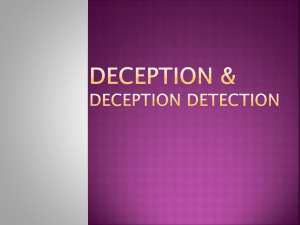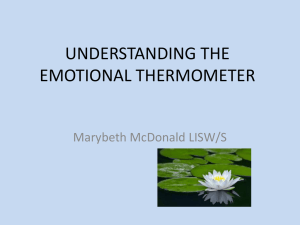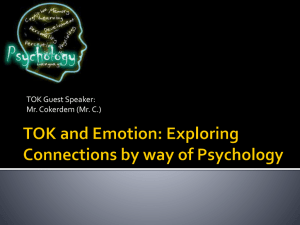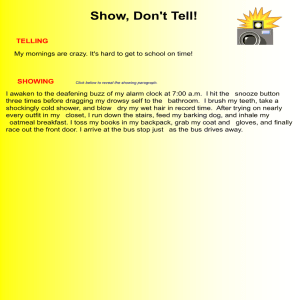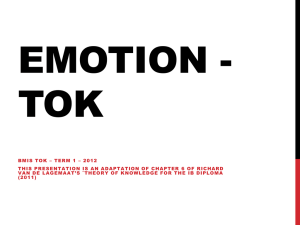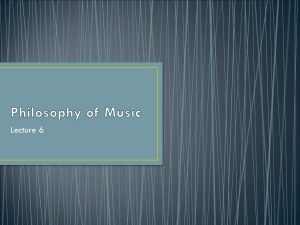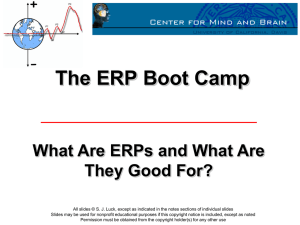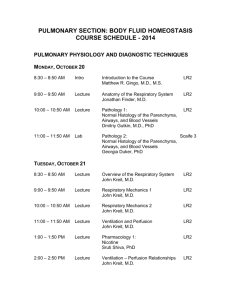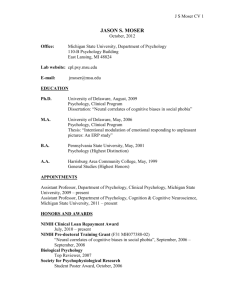Konstanz EmoReg - University of Delaware
advertisement
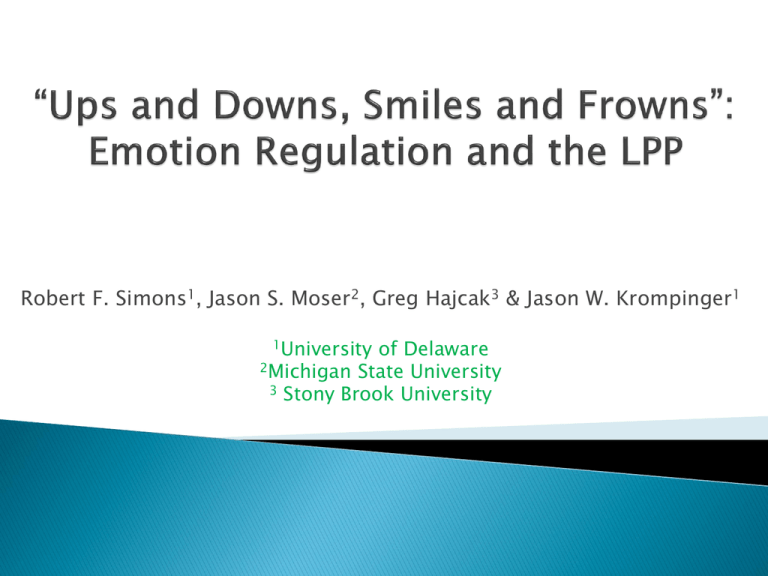
Robert F. Simons1, Jason S. Moser2, Greg Hajcak3 & Jason W. Krompinger1 1University of Delaware 2Michigan State University 3 Stony Brook University Snoop Dogg Introduction ◦ Emotion regulation ◦ Event-related brain potentials (ERPs) Main Focus ◦ Sensitivity of ERPs to affective content of pictures ◦ Can ERPs be modulated by emotion-regulation instructions? ◦ What are some temporal characteristics of different types of emotion regulation? ◦ Reappraisal v. Suppression – Does strategy matter? ◦ An emotion-cognition interaction What to do next? Introduction ◦ Emotion regulation Dysregulation thought to underlie a variety of psychopathologies An example of emotion-cognition interaction Cognitive control of emotion Manipulate (regulate) emotion – How does it impact cognition? ◦ Event-related brain potentials (ERPs) Early studies focused on autonomic measures Most current work involves fMRI ERPs have advantages Direct manifestation of neural activity Real-time measure Sensitive to affective properties of eliciting stimuli Introduction ◦ Emotion regulation ◦ Event-related brain potentials (ERPs) Main Focus ◦ Sensitivity of ERPs to affective content of pictures ◦ Can ERPs be modulated by emotion-regulation instructions? Does valence matter? Do specific instructions matter? Does direction of regulation matter? ◦ What are some temporal characteristics of different types of emotion regulation? Summary & Plans Lang et al., 1999 LPP • Larger for motivationally relevant stimuli LPP • Reflects facilitated attentional/ perceptual processing Schupp et al., 2000 LPP • Larger for motivationally relevant stimuli • Sustained for picture duration LPP Cuthbert et al., 2000 LPP • Larger for motivationally relevant stimuli • Motivational differences sustained past slide termination Hajcak & Olvet, 2008 Introduction ◦ Emotion regulation ◦ Event-related brain potentials (ERPs) Main Focus ◦ Sensitivity of ERPs to affective content of pictures ◦ Can ERPs be modulated by emotion-regulation instructions? Does valence matter? Do specific instructions matter? Does direction of regulation matter? ◦ What are some temporal characteristics of emotion regulation? What to do next? ”The extrinsic or intrinsic processes responsible for monitoring, evaluating and modifying emotional reactions, especially their intensity and temporal features … “ (Thompson, 1994, pp. 27-28) Attentional Deployment ◦ Overt or covert refocusing Cognitive reappraisal ◦ Think about the stimulus from different perspectives ◦ Think about possible outcomes for the stimulus Behavioral expression regulation ◦ Control facial expressions of emotion Attentional Deployment ◦ Overt or covert refocusing Cognitive reappraisal ◦ Think about the stimulus from different perspectives ◦ Think about possible outcomes for the stimulus Behavioral expression regulation ◦ Control facial expressions of emotion Attending to Affect • Decisions • Judge Valence • Count people Hajcak, Moser & Simons, 2006 Attending to Affect • Attentional Focus • Cue at Onset • Cue at 3000 ms Dunning & Hajcak, 2008 Attending to Affect • Attentional Focus • Tone cues at 3000 ms • Attend neutral content • Attend arousing content Hajcak, Dunning & Foti, 2008 Attentional Deployment ◦ Overt or covert refocussing Cognitive reappraisal ◦ Think about the stimulus from different perspectives ◦ Think about possible outcomes for the stimulus Behavioral expression regulation ◦ Control facial expressions of emotion Moser, Hajcak, Bukay & Simons, 2006 Block 1 50% Instruction to View Naturally 50% Blocks 2 & 3 SUPPRESS ENHANCE Fix 2000 ms 500 ms 1000 ms View Moser et al., 2000 Regulate View = Enhance > Suppress Hajcak & Nieuwenhuis, 2006 LPP • Pictures preceded by brief description • Reappraisal without effort • Effects present at 30 minute representation The harmless snake is in a zoo exhibit. The snake is about to attack. Foti & Hajcak, 2008 Krompinger, Moser & Simons, 2008 Block 1 50% Instruction to View Naturally 50% Blocks 2 & 3 SUPPRESS ENHANCE Fix 2000 ms 500 ms 1000 ms View Pz Pleasant Neutral -4 -2 microvolts 0 2 4 6 8 10 12 -200 0 200 400 600 800 time (ms) Krompinger et al., 2008 Regulate Pz View Suppress Enhance -4 -2 microvolts 0 2 4 6 8 10 12 -200 0 200 400 time (ms) View = Enhance > Suppress 600 800 Moser, Krompinger, Dietz & Simons, 2009 Block 1 LOOK DECREASE Block 2 LOOK INCREASE B/F 2000 ms 1000 ms 4000 ms • Pre-pic effects •SPN • Picture effects •LPP • Pre-pic effects •SPN • Picture effects •LPP Look ◦ “I looked at the picture and let my emotions run naturally.” Decrease ◦ “I looked at the pictures as if I was detached from the situation.” Increase ◦ “I tried to view them as happening to someone I know.” Pre-picture (SPN) effects ◦ Decrease associated with increased preparatory activity ◦ No increase effect Picture (LPP) effects ◦ Decrease and increase associated with similar time course; starting at ~400ms ◦ Emotion regulation occurred ~100ms after emotion effect ◦ Regulation is not a filter The LPP seems to be a viable measure of emotion regulation outcome and together with other ERP components can provide insights into emotion regulation processes Timing of emotion regulation quite fast ◦ Regulation seems to follow shortly after emotion effects… ◦ and, can involve preparation prior to stimulus onset Moser, Krompinger, Dietz & Simons, in preparation Group 1 LOOK REAPPRAISE Group 2 LOOK SUPPRESS B/F 2000 ms 1500 ms 6000 ms Results: LPP -4 Look -2 Pz -4 -2 Reappraise 0 2 2 4 4 6 6 8 8 10 10 12 12 uV 0 14 -200 Look Suppress 14 800 1800 2800 3800 4800 5800 -200 time (ms) 800 1800 2800 3800 4800 5800 Results: Emotion Intensity Results: Effort 5 4.5 4 3.5 3 Look 2.5 Regulate 2 1.5 1 0.5 0 Reappraise Suppress Moser, Most & Simons, 2010 Block 1 1 11 111 ‘LOOK’ ‘DECREASE’ 2 22 222 Block 2 ‘LOOK’ 3 33 333 ‘INCREASE’ 2000 ms 2000 ms 1800 ms 500 ms Results: Stroop Interference Dietz, 2009 Low Anxious High Anxious Dietz, 2008

